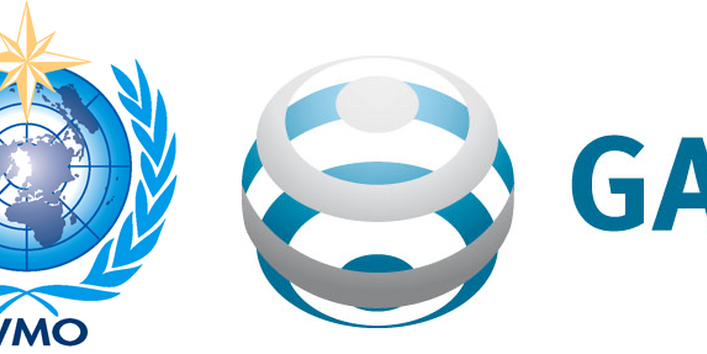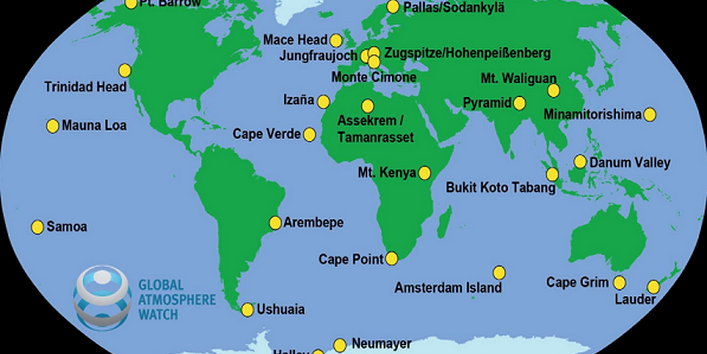In keeping with the specific data quality requirements, all data processing steps starting from the acquisition of raw data in the time range of seconds to the production of quality-assured half hour mean values have to be performed at the station. A special software system for data collection and quality assurance at GAW stations was developed in a project commissioned by the Federal Environment Agency under the Environmental Research Plan of the German Environment Ministry. In order to facilitate international standardisation of data processing at GAW stations, developed software components are available to GAW stations free of charge. For further information please refer to „Standardized and automated data quality assurance at GAW Stations: concept, methods and tools“.
Results
Atmospheric peroxyacetyl nitrate (PAN): a global budget and source attribution
E. V. Fischer, D. J. Jacob, R. M. Yantosca, M. P. Sulprizio, D. B. Millet, J. Mao, F. Paulot, H. B. Singh, A. Roiger, L. Ries, R.W. Talbot, K. Dzepina, S. Pandey Deolal; Atmospheric Chemistry and Physics (Impact Factor: 4.88). 03/2014; 14:2679-2698. DOI:10.5194/acp-14-2679-2014.
Nitrogen deposition along differently exposed slopes in the Bavarian Alps
Manfred Kirchner, Wolfgang Fegg, Horst Römmelt, Michael Leuchner, Ludwig Ries, Ralf Zimmermann, Bernd Michalke, Markus Wallasch, Jürgen Maguhn, Theresa Faus-Kessler, Gert Jakoi, Helmholtz Zentrum München, Cooperation Group "Comprehensive Molecular Analytics", Ingolstaedter Landstrasse 1, D-85764 Neuherberg, Germany. Science of The Total Environment (Impact Factor: 3.26). 11/2013; 470-471C:895-906. DOI:10.1016/j.scitotenv.2013.10.036.
Dafit - a new workflow oriented approach for time efficient data preparation, validation and flagging of time series data from environmental monitoring
L.Ries. In: Proceedings of the 27th conference on Environmental informatics – Informatics for Environmental Protection, Sustainable Development and Risk Management, Part II, pp. 651-656, Shaker Verlag, 2013, Aachen, 938.p, ISBN 979.3-8440-1676-5.
Altitudinal temperature lapse rates in an Alpine valley: trends and the influence of season and weather patterns
Manfred Kirchner, Theresa Faus-Kessler, Gert Jakobi, Michael Leuchner, Ludwig Ries, Hans-Eckhart Scheel, Peter Suppan, International Journal of Climatology 03/2013; 33(3):539-555.
Number Size Distributions and seasonality of Submicron Particles in Europe 2008–2009
A. Asmi, A. Wiedensohler, P. Laj, A.-M. Fjaeraa, K. Sellegri, W. Birmili, E. Weingartner, U. Baltensperger, V. Zdimal, N. Zikova, [...], G. Deleeuw, B. Henzing, R.M. Harrison, D. Beddows, C. O’Dowd, H. Flentje, K.Weinhold, F. Meinhardt, L. Ries, M. Kulmala; Atmospheric Chemistry and Physics,01/2011; 11:5505-5538.
Influences of the 2010 Eyjafjallajokull volcanic plume on air quality in the northern Alpine region
K Schaefer, W Thomas, A Peters, L Ries, F Obleitner, J Schnelle-Kreis, W Birmili, J Diemer, W Fricke, W Junkermann, [...], H Flentje, S Gilge, H E Wichmann, F Meinhardt, R Zimmermann, K Weinhold, J Soentgen, C Muenkel, C Freuer, J Cyrys; Atmospheric Chemistry and Physics, 01/2011; 11(16):8555-8575.
Measurement and simulation of the 16/17 April 2010 Eyjafjallajokull volcanic ash layer dispersion in the northern Alpine region
S Emeis, R Forkel, W Junkermann, K Schaefer, H Flentje, S Gilge, W Fricke, M Wiegner, V Freudenthaler, S Gross, L Ries, F Meinhardt, W Birmili, C Muenkel, F Obleitner, P Suppan
Atmospheric Chemistry and Physics 01/2011; 11(6):2689-2701.
A case of transatlantic aerosol transport detected at the Schneefernerhaus Observatory (2650 m) on the northern edge of the Alps
Wolfram Birmili, Tina Obel, And E Sonntag, Ludwig Ries, Ralf Sohmer, Stefan Gilge, Ingeborg Levin, Andreas Stohl; Meteorologische Zeitschrift, Bd. 9, Heft 6, 01/2011; 19:591-600.
Temporal and spatial structure of a volcanic ash cloud: ground-based remote sensing and numerical modeling
Klaus Schäfer, Wolfram Birmili, Josef Cyrys, Stefan Emeis, Renate Forkel, Stefan Gilge, Christoph Münkel, Mike Pitz, Ludwig Ries, Peter Suppan; Proc SPIE 10/2010;
Continuous aerosol observations in the German Ultrafine Aerosol Network (GUAN)
W. Birmili, K. Weinhold, S. Nordmann, A. Wiedensohler, G. Spindler, K. Müller, H. Herrmann, T. Gnauk, M. Pitz, J. Cyrys, H. Flentje, C. Nickel, T. A. J. Kuhlbusch, G. Löschau, F. Meinhardt, A. Schwerin, L. Ries, H. Gerwig, K. Wirtz; International Aerosol Conference 2010, Helsinki, Finland; 08/2010
Spatial structure and dispersion of the 16/17 April 2010 volcanic ash cloud over Germany
Emeis S, Junkermann W, Schäfer K, Forkel R, Suppan P, Flentje H, Gilge S, Fricke W, Wiegner M, Freudenthaler V, Groß S, Ries L, Meinhardt F, Münkel C, Obleitner F Atmospheric Chemistry and Physics 01/2010;
Ozone, carbon monoxide and nitrogen oxides time series at four alpine GAW mountain stations in central Europe
Gilge S, Plass-Duelmer C, Fricke W, Kaiser A, Ries L, Buchmann B, Steinbacher M., Atmospheric Chemistry and Physics, 01/2010;
Transport of nitrogen oxides, carbon monoxide and ozone to the Alpine Global Atmosphere Watch stations Jungfraujoch (Switzerland), Zugspitze and Hohenpeissenberg (Germany), Sonnblick (Austria) and Mt. Krvavec (Slovenia)
August Kaiser, Helfried Scheifinger, Wolfgang Spangl, Andrea Weiss, Stefan Gilge, Wolfgang Fricke, Ludwig Ries, Danijel Cemas, Brigita Jesenovec Atmospheric Environment 41 (2007) 9273–9287
How to Keep the Quality Chain, Work Flow-Oriented Data Processing for Global Atmosphere Watch Measurement Stations.
L.Ries, pp. 109-112,
In: Environmental Informatics and Systems Research. Vol. 2 Workshop and application papers. Eds. Olgierd Hryniewicz, Jan Studzinski, Anna Szediw. Shaker Verlag, 2007, Aachen, 292 p.
Final Report on CarboEurope ‚Cucumber‘ Intercomparison Programme
Manning A.C., Jordan A., Levin I., et. Al., 2008
Atmospheric aerosol measurements in the German Ultrafine Aerosol Network (GUAN) Part 1: Soot and particle number size distributions
W. Birmili, K. Weinhold, S. Nordmann, A. Wiedensohler, G. Spindler, K. Müller, H. Herrmann, T. Gnauk, M. Pitz, J. Cyrys, H. Flentje, C. Nickel, T. A. J. Kuhlbusch, G. Löschau, D. Haase, F. Meinhardt, A. Schwerin, L. Ries, K. Wirtz, Gefahrstoffe – Reinhaltung Luft, 69(4), 2009, S. 137-145.
Observation and origin of organochlorine compounds and polycyclic aromatic hydrocarbons in the free troposphere over central Europe.
Gerhard Lammel, Jana Klánová, Jiří Kohoutek, Roman Prokeš, Ludwig Ries and Andreas Stohl, Environmental Pollution, Article in Press, 2009
Feine und ultrafeine Aerosolpartikeln an der GAW-Station Schneefernerhaus/Zugspitze
Birmili, W.; Ries, L.; Sohmer, R.; Anastou, A.; Sonntag, A.; König, K.; Levin, I. , Gefahrstoffe- Reinhaltung der Luft 1-2/2009, Seite 31-35
The data for greenhouse gases and reactive gases are transferred to the World Data Centre for Greenhouse Gases (WDCGG) in Japan. Data on aerosols is submitted to the World Data Centre for Aerosols.



